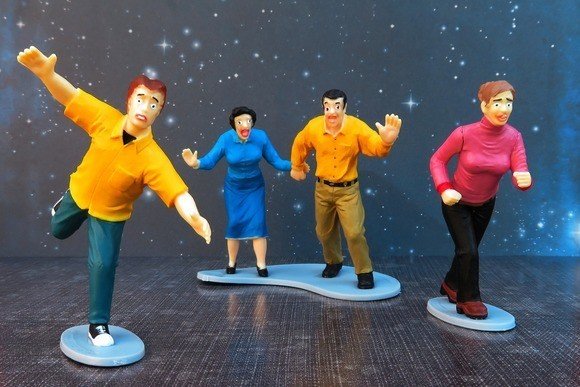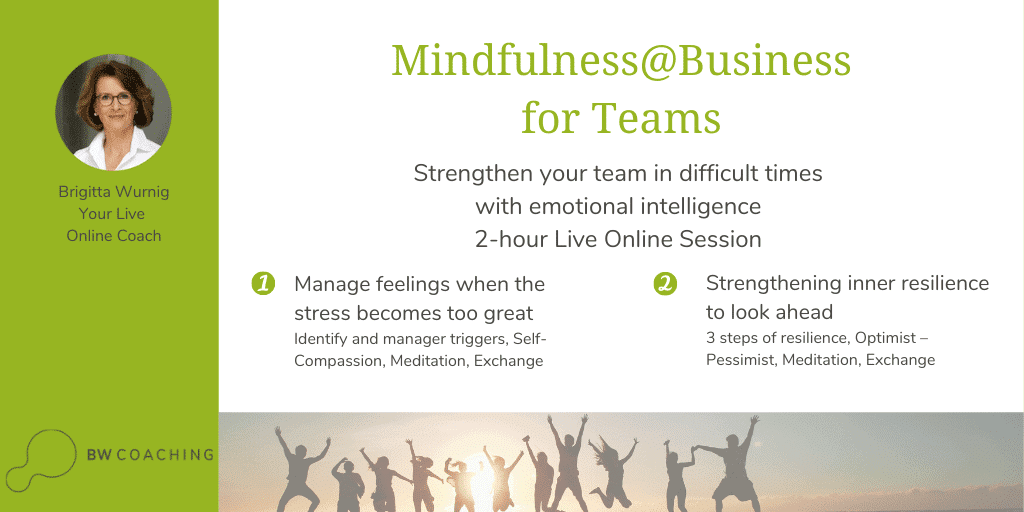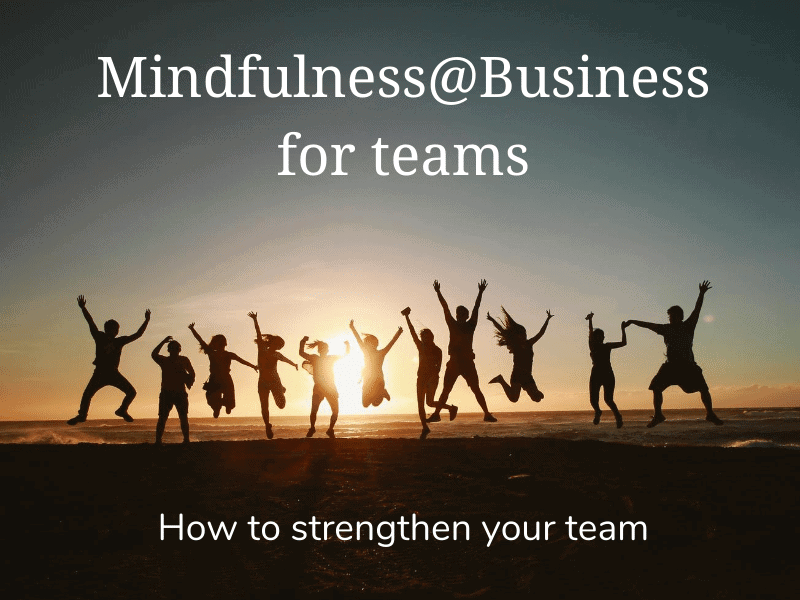How have you been in recent weeks? Do you feel good or are you mentally exhausted? How does everyday life work in the Corona-influenced team?
Today I write about the emotional phases we deal with and process during our return to “normal” everyday life. You will learn how teams can support each other in the current change situation. And I introduce you to my “Mindfulness@Business for teams” which I offer as a gift for you.
Back to the “normal” life does not just mean to continue where we left off in March 2020
In March 2020, in front of my inner eye, I saw armies of office men pulling into the home office with their laptops and monitors. Almost brutally we had to prepare ourselves for a life situation that we could not have imagined until then and was not wanted in the form of us either.
Familiar work structures collapsed. Partners and children all day home, home schooling or loneliness and silence, household and job at the same time, hobbies shut down, social distancing and above all hung the uncertainty as to how and when it will continue. Sometimes it seemed like a large open-air prison where we were suddenly locked up and didn’t know when we would be released back into freedom.
Mentally, many were in shock, because the brain recognized a threat and triggered different reflexes as in the primeval times of our existence. Our amygdala, the brain region that is activated in case of danger and triggering, had us firmly under control.

Daniel Goleman, author of Emotional Intelligence, aptly refers to this state as “Amygdala Highjack”.
Fight-flight-freeze rigids are the three typical reactions to shock and danger. Our fears, which were so far well-controlled or perhaps ignored, immediately came to the surface. As a backlash, many tried to, capture their usual structures, which of course didn’t work, because the world went crazy and we with her.
At McKinsey Insights (1) I read about how a crisis can trigger a number of physiological and psychological reactions. Global crises can also cause mass trauma responses, as collective fears and existential threats upset the balance and weaken social isolation ties that usually provide emotional support. Collective panic can lead to a reaction of “escape and closeness” in which people seek familiar places and contact to feel safe. Previous traumas resurface. The lost sense of security and normality can trigger grief, and with it feelings of shock, denial, anger and depression.
In many conversations over the past few weeks, my clients, friends, and family often talked about these extraordinary emotional states. This constant fear of an invisible virus permanently activates our brain regions, which are responsible for anxiety and suffering. We train our brains to be scared, so to speak. No wonder we don’t come to rest and feel mentally exhausted.
Now, in front of my inner eye, I see these armies partially returning, seeing them look around the empty offices and carefully groping back everyday life. The other part is still at home, either continuing to struggle with the organization of family life or doing exactly the opposite, namely to enjoy the gained independence and concentrated peace in the home office. And then there are the companies that basically continued as usual and had to cope with little change.

So our world is still VUCA, i.e. Volatile, Uncertain, Complex and Ambiguous.
And again, our amygdala is activated and we react compulsively, because we do not find ourselves in the usual working conditions. Even if the office or canteen are still in the same place, the rules and rituals of coexistence have changed significantly. Masks, distance, upper limits for meetings, regulated handling of outsiders or food delivery with regulations are visible signs that we are still not “free” from the corona scourge.
After the long shock and anxiety phase, do I simply return to business-as-usual? Can I talk to my colleagues and superiors about my fears and thoughts? And what do I do when I’m back in the office and meeting my colleagues?
“We don’t want to go back to the hamsterwheel,” I say in the NDR Info TV report about the working world in and after Corona. Instead, I am convinced “… that a cultural revolution in companies…” must take place, so that our working world changes sustainably so that we like to continue working in it and can thrive both personally and professionally!
When I read the aforementioned McKinsey article, I felt very strongly that mindfulness and compassion are the success factors for the new way of leadership and corporate culture. The authors describe qualities that are crucial for leaders to care for people in times of crisis and to create the conditions for a business recovery: awareness, vulnerability, empathy and compassion. In my opinion, these qualities apply to all people and are important even after the crisis.
Leading Teams with compassion
As a leader, you realize that switching to home office and zoom-conferencing is not enough to equip the new working environments to make your teams effective. I find it remarkable how rarely the mental and emotional concerns of the teams and managers are addressed at the moment. I heard from executives who hadn’t signed up to their teams for three months or were just talking about business in the team calls, rather than inquiring about the team’s condition.
Luckily, there are also the other empathetic executives who used regular calls to exchange ideas and took care of the personal issues. These executives realized that all people are and feel, the need to talk about what has moved us over the last few months and is still moving us. When we can give our feelings a language, name them, our amygdala calms down and we get back into thinking and acting. Our prefrontal cortex then sends instructions to the amygdala on how best to deal with the overwhelming feelings. We see clearer, we are regaining courage and we see ways to move forward. The exchange in a team therefore supports our mental hygiene and at the same time strengthens our inner resilience.
Now we don’t want to experience endless whining rounds, because that doesn’t get us any further and just pulls us down again. We need a room in the team that allows open conversations about emotions while allowing team members to reorient and act.

Mindfulness@Business for Teams – My free offer to you
I have adapted my mindfulness program Mindfulness@Business, which was already successfully launched for individuals in April, to the current team situations. In a two-hour online-Zoom-Session, teams reflect and work on two important topics for mental hygiene:
- Manage feelings when the stress becomes too great
- Strengthening inner resilience to look ahead
Team members learn to recognize and manage their personal triggers to escape the Amygdala Highjack. They develop self-compassion and develop 3 steps of resilience to strengthen the optimist in themselves. In addition to thematic input, teams are guided through strengthening meditations and exchange experiences in small groups.
My free offer to you until the end of September 2020: book a free two-hour Mindfulness@Business for teams. Fill in our contact form with your wish date.
Why no fee for these precious hours? – Map of Love
The need for appreciative awareness and coping with our extraordinary situation has led to a worldwide wave of free online offerings for mindfulness, meditation, yoga and relaxation exercises in recentmonths.
I took part in the daily online meditations with Jon Kabat-Zinn, which he conducted over 13 weeks. It was a profound experience to meditate and learn more about mindfulness with the founder of MBSR (Mindfulness Based Stress Reduction) and thousands of others from around the world. It helped me keep grounded during the crisis and to strengthen my inner serenity. Sören Gordhamer, founder of the global mindfulness conference Wisdom 2.0, sponsored this series because he firmly believes that humanity only emerges from this time strengthened by compassion and love.
In the meantime, my business has started again and at the same time this experience of generosity, compassion and connection aroused in me the desire to pass on something of my community. That’s what I’m doing today with Mindfulness@Business for teams.
On the Map of Love – a map of compassion and love in the world – you will find people who want to bring inspiration and love to the world inspired by the Wisdom 2.0 community experience. I am glad that you will let yourself be infected by the spark.
If your compliance rules do not allow free offers, contact me and we will agree a fee that is equal to the value you deem appropriate.



